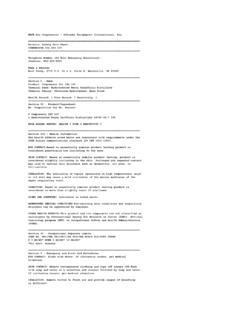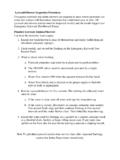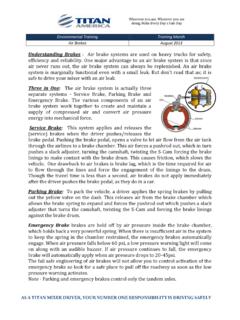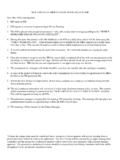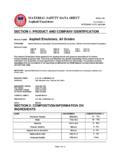Transcription of MATERIAL SAFETY DATA SHEET - 5700 / Acrylic Lacquer …
1 MSDS 5700 / Acrylic Lacquer thinner MATERIAL SAFETY data SHEET - 5700 / Acrylic Lacquer thinner section 1 - CHEMICAL, PRODUCT, AND COMPANY INFORMATION. PRODUCT CODE/IDENTITY: 5700 / Acrylic Lacquer thinner - Economy Grade REVISION DATE: 04/01/99. CUSTOMER PART #/NAME: PRODUCT TRADE NAME: BBLEND #9511 CP-10. CHEMICAL FAMILY: EMERGENCY MEDICAL/SPILL INFO: (800) 800-424-9300 CHEM TREC. (502) 358-0261. TECHNICAL INFORMATION: PRODUCT SAFETY /MSDS INFORMATION: Box 16038. LOUISVILLE, KY 40256-0038. DATE OF MSDS PREPARATION: 04/26/99. HAZARD RATINGS: HEALTH (NFPA): 2. HEALTH (HMIS): 2. FLAMMABILITY: 3. REACTIVITY: 0. PRIMARY HAZARD WARNING. Flammable. Keep away from heat, sparks, flames, and other sources of ignition. Do not smoke. Extinguish all flames and pilot lights. Turn off stoves, heaters, electrical motors, and other sources of ignition during use and until all vapors/odors are gone. Harmful if swallowed.
2 May cause moderate skin irritation. Causes severe eye irritation. May be absorbed through the skin. Vapor and/or spray mist may be harmful if inhaled. Vapor irritates eyes, nose, and throat. THIS MATERIAL SAFETY data SHEET HAS BEEN PREPARED IN ACCORDANCE WITH THE OSHA HAZARD. COMMUNICATION STANDARD (29 CFR ), THE SUPPLIER NOTIFICATION REQUIREMENTS OF SARA. TITLE III, section 313, AND OTHER APPLICABLE RIGHT-TO-KNOW REGULATIONS. section 2 - COMPOSITION/INFORMATION ON INGREDIENTS. All components of this product are on the TSCA list. SARA Title III section 313 Supplier Notification. This product contains the indicated <*> toxic chemicals subject to the reporting requirements of section 313 of the Emergency Planning & Community Right-To-Know Act of 1986 and of 40 CFR 372. This information must be included in all MSDSs that are copied and distributed for this MATERIAL . SARA TITLE III WT. % (REG.)
3 CAS# RQ (LBS). INGREDIENTS section ). 50. Toluene 108-88-3 1000. (311,312,313,RCRA). 19. Methanol 67-56-1 5000. (311,312,313,RCRA). Light Aliphatic Solvent *64742-89-8 Not Appl. (311,312) None Naphtha Acetone 67-64-1 Not Appl. (311,312) 5000. Page 1. MSDS 5700 / Acrylic Lacquer thinner SARA section . 311/312 Hazards: Acute Health Fire TWA TLV. MATERIAL CAS# HAP. (OSHA) (ACGIH). Toluene 108-88-3 200 ppm 50 ppm YES. Methanol 67-56-1 200 ppm (S) 200 ppm (S) YES. Light Aliphatic Solvent *64742-89-8 500 ppm 300 ppm NO. Naphtha Acetone 67-64-1 1000 ppm 750 ppm NO. In addition to EPA Hazardous Air Pollutants showing 'YES' under "HAP" above, using manufacturers' data , based on EPA Method 311, the following EPA Hazardous Air Pollutants may be present in trace amounts (less than ): BENZENE, MIXED XYLENES, ETHYLBENZENE. MATERIAL CAS # Ceiling STEL (OSHA/ACGIH). None Methanol 67-56-1 250 ppm Known None Acetone 67-64-1 1000 ppm Known CALIFORNIA PROPOSITION 65: This product contains the following chemicals known to the State of California to cause cancer and reproductive toxicity: Benzene, Toluene DOT SHIPPING NAME: Paint Related MATERIAL , 3, UN1263, PG-II.
4 section 3 - HAZARDS IDENTIFICATION. MATERIAL CAS # LOWEST KNOW LETHAL DOSE data . mg/kg (MAN) Lowest Known LC50. Methanol 67-56-1. (VAPORS). Toluene 108-88-3 5300 ppm (Mice) Lowest Known LD50 (SKIN). Toluene 108-88-3 mg/kg (Rabbits). THRESHOLD LIMIT VALUE: 100 ppm (Evaporated Blend). CONTAINS: Toluene, Methanol, Light Aliphatic solvent naphtha, acetone DANGER! EXTREMELY FLAMMABLE! VAPORS CAN CAUSE FLASH FIRE! POISON! ACUTE HAZARDS. EYE & SKIN CONTACT: Primary irritation to skin, defatting, dermatitis. Absorption thru skin increases exposure. Primary irritation to eyes, redness, tearing, blurred vision. Liquid can cause eye irritation. Wash thoroughly after handling. INHALATION: Anesthetic. Irritates respiratory tract. Acute overexposure can cause serious nervous system depression. Vapor harmful. Breathing vapor can cause irritation. Acute overexposure can cause damage to kidneys, blood, nerves, liver and lungs.
5 Repeated exposure over TLV can cause blindness. SWALLOWING: Can be fatal or cause blindness if swallowed. Cannot be made non-poisonous. Poison I can cause irreversible nervous system damage and death. Harmful or fatal if swallowed. Swallowing can cause abdominal irritation, Page 2. MSDS 5700 / Acrylic Lacquer thinner nausea, vomiting and diarrhea. SUBCHRONIC HAZARDS/CONDITIONS AGGRAVATED. CONDITIONS AGGRAVATED: Chronic overexposure can cause damage to kidneys, blood, nerves, liver and lungs. Persons with severe skin, liver or kidney problems should a void use. CHRONIC HAZARDS. CANCER, REPRODUCTIVE AND OTHER CHRONIC HAZARDS: This product has no carcinogens listed by IARC, NTP, NIOSH, OSHA or ACGIH, as of this date, greater or equal to This product may contain less than 1 ppm of Benzene. Not considered hazardous in such low concentrations. Absorption thru skin may be harmful. studies with laboratory animals indicate this product can cause damage to fetus.
6 section 4 - FIRST AID MEASURE PROCEDURES. EYE CONTACT: In case of eye contact, remove contact lenses and flush eyes immediately with a gentle stream of warm water for at least 15 minutes. SKIN CONTACT: In case of skin contact, flush immediately with plenty of water for at least 15 minutes followed by washing with soap and water. INHALATION: If affected by inhalation of vapor or spray mist, remove to fresh air. Apply artificial respiration and other support measures as required. OTHER: If ingestion, any type of overexposure or symptoms of overexposure occur during or following the use of this product, contact a poison control center, emergency room or physician immediately; have MATERIAL SAFETY data SHEET information available. SWALLOWING: Induce vomiting promptly using physician's instructions or by having patient stick finger down throat. After vomiting has been induced, give two teaspoons of baking soda in a glass of water.
7 CALL A PHYSICIAN. Never give anything by mouth to an unconscious person. Have patient lie down and keep warm. Cover eyes to exclude light. section 5 - FIRE FIGHTING MEASURES. AUTO IGNITION TEMPERATURE: 290 C / 555 F (lowest Component). LOWER FLAMMABLE LIMIT IN AIR (percent by volume): FLASHPOINT: -16 C / 2 F (TCC) (Lowest Component). FLAMMABILITY CLASSIFICATION: Class I B. EXTINGUISHING MEDIA: Use National Fire Protection Association (NFPA) Class B extinguishers (carbon dioxide, dry chemical, or universal aqueous film forming foam) designed to extinguish NFPA Class IC flammable liquid fires. SPECIAL FIRE FIGHTING PROCEDURES: Water spray may be ineffective. Water spray may be used to cool closed containers to prevent pressure build-up and possible autoignition or explosion when exposed to extreme heat. If water is used, fog nozzles are preferable. Do not enter confined space without full bunker gear.
8 Fire-fighters should wear self-contained breathing apparatus and full protective clothing. UNUSUAL FIRE AND EXPLOSION HAZARDS: EXTREMELY FLAMMABLE! VAPORS CAN CAUSE FLASH FIRE. Keep container tightly closed. Keep this product away from heat, sparks, flame, and other sources of ignition ( , pilot lights, electric motors, static electricity). Invisible vapors can travel to a source of ignition and flash back. Do not smoke while using this product. Keep containers tightly closed when not in use. Closed containers may explode when overheated. Do not apply to hot surfaces. Toxic gases may form when this product comes in contact with extreme heat. section 6 - ACCIDENTAL RELEASE MEASURES. SPILL OR LEAK PROCURES: - Stop spill at source. Dike area and contain. Clean up remainder with absorbent materials. Mop up and dispose of. Persons without proper protection should be kept from area until cleaned up.
9 WASTE DISPOSAL METHOD: - Recycle or dispose of observing local, state and federal health, SAFETY and pollution laws. If questions exist, contact the appropriate agencies. OTHER PRECAUTIONS: - Vapors may ignite explosively and spread long distances. Prevent vapor buildup. Put out pilot lights and turn off heaters, electric equipment and other ignition sources during use and until all vapors are gone. section 7 - HANDLING AND STORAGE. Page 3. MSDS 5700 / Acrylic Lacquer thinner HANDLING - Isolate from oxidizers, heat, sparks, electric equipment and open flame. Use only with adequate ventilation. Avoid breathing of vapor or spray mist. Avoid contact with skin and eyes. Wear OSHA Standard goggles or face shield. Consult SAFETY Equipment Supplier. Wear gloves, apron and footwear impervious to this MATERIAL . Wash clothing before reuse. Avoid free fall of liquid. Ground containers when transferring.
10 Do not flame cut, saw, drill, braze, or weld. Empty container very hazardous! Continue all label precautions. STORAGE - Vapors may ignite explosively and spread long distances. Prevent vapor buildup. Put out pilot lights and turn off heaters, electric equipment and other ignition sources during use and until all vapors are gone. Do not store above 49. C /120 F. Store large amounts in structures made for OSHA Class I B liquids. Keep container tightly closed and upright when not in use to prevent leakage. section 8 - EXPOSURE CONTROLS AND PERSONAL PROTECTION. EXPOSURE CONTROLS: - Ventilate to keep vapors of this MATERIAL below 50 ppm. If over TLV, in accordance with 229. CFR , use NIOSH approved positive-pressure self-contained breathing apparatus. Consult SAFETY Equipment Supplier. Use explosion-proof equipment. VENTILATION: Local Exhaust: Necessary Mechanical (general): Acceptable Special: None Other: None PERSONAL PROTECTIONS: - Wear OSHA Standard goggles or face shield.



